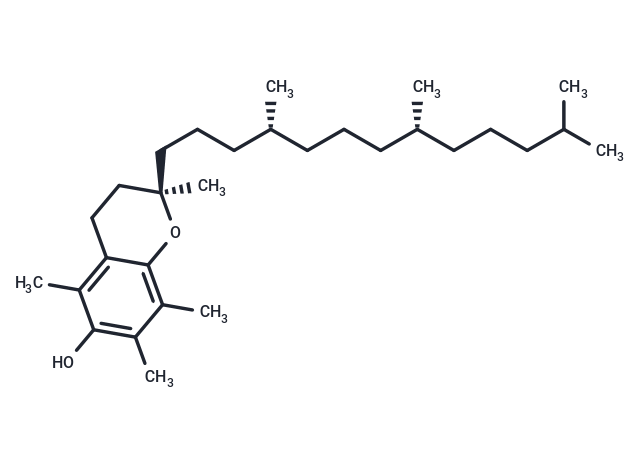Shopping Cart
- Remove All
 Your shopping cart is currently empty
Your shopping cart is currently empty

α-Vitamin E (Dexrabeprazole Sodium) is a naturally-occurring form of vitamin E, a fat-soluble vitamin with potent antioxidant properties.

| Pack Size | Price | Availability | Quantity |
|---|---|---|---|
| 50 mg | $38 | In Stock | |
| 1 mL x 10 mM (in DMSO) | $50 | In Stock |
| Description | α-Vitamin E (Dexrabeprazole Sodium) is a naturally-occurring form of vitamin E, a fat-soluble vitamin with potent antioxidant properties. |
| In vitro | vitamin E is capable of inducing necrosis in TC-1 cells and has antioxidant effects against nitric oxide[1]. |
| In vivo | Vitamin E induces TC-1 cell necrosis in vivo and reduces tumor volume in TC-1 tumor-bearing mice. Vitamin E reduces myeloid derived suppressor cells(MDSCs) in tumors of TC-1 tumor-bearing mice and enhances T cell accumulation[1]. |
| Cell Research | For in vitro cytotoxicity experiments, 1×105 TC-1 cells per well are added to 24-well plates. Eighteen hours later, tumor cells are treated with Vitamin E (0, 25, 50 μM). After 18 hours, apoptotic (Annexin V+ and 7AAD−) and necrotic (Annexin V+ and 7AAD+) cells are measured using PE Annexin V Apoptosis Detection Kit I. (Only for Reference) |
| Alias | Vitamin E, D-α-Tocopherol, Alpha-Tocopherol, 5,7,8-Trimethyltocol, (+)-alpha-Tocopherol |
| Molecular Weight | 430.71 |
| Formula | C29H50O2 |
| Cas No. | 59-02-9 |
| Smiles | CC1=C2C(CC[C@](CCC[C@@H](CCC[C@@H](CCCC(C)C)C)C)(C)O2)=C(C)C(O)=C1C |
| Relative Density. | 0.95g/mLat 25°C(lit.) |
| Storage | Powder: -20°C for 3 years | In solvent: -80°C for 1 year | Shipping with blue ice. | ||||||||||||||||||||||||||||||
| Solubility Information | DMSO: 12 mg/mL (27.86 mM), Sonication is recommended. 10% DMSO+40% PEG300+5% Tween 80+45% Saline: 1.2 mg/mL (2.79 mM), In vivo: Please add the solvents sequentially, clarifying the solution as much as possible before adding the next one. Dissolve by heating and/or sonication if necessary. Working solution is recommended to be prepared and used immediately. Saline: 25 mg/mL (58.04 mM), In vivo: Please add co-solvents sequentially, clarifying the solution as much as possible before adding the next one. Dissolve by heating and/or sonication if necessary. Working solution is recommended to be prepared and used immediately. | ||||||||||||||||||||||||||||||
Solution Preparation Table | |||||||||||||||||||||||||||||||
DMSO/Saline
Saline
| |||||||||||||||||||||||||||||||

Copyright © 2015-2025 TargetMol Chemicals Inc. All Rights Reserved.